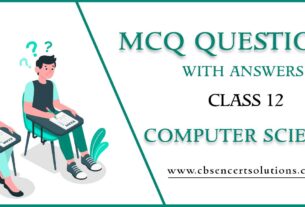Check the below NCERT MCQ Class 12 History Chapter 13 Mahatma Gandhi and The Nationalist Movement with Answers available with PDF free download. MCQ Questions for Class 12 History with Answers were prepared based on the latest syllabus and examination pattern issued by CBSE, NCERT and KVS. Our teachers have provided below Mahatma Gandhi and The Nationalist Movement Class 12 History MCQs Questions with answers which will help students to revise and get more marks in exams
Mahatma Gandhi and The Nationalist Movement Class 12 History MCQ Questions with Answers
Refer below for MCQ Class 12 History Chapter 13 Mahatma Gandhi and The Nationalist Movement. Solve questions and compare with the answers provided below
Question. Indicate which of the following options is not correct:
(A) Muslim League demanded Pakistan in 1946.
(B) Gandhiji started Quit India Mission in 1942.
(C) Cripps Mission failed to achieve its objective.
(D) Cabinet Mission arrived in India in 1946.
Answer
A
Question. Which of the following statement(s) is/are incorrect regarding the Indian freedom struggle:
(A) Gandhiji withdrew from the non-cooperation movement due to the chauri chaura incident.
(B) Gandhiji gave his first public speech at BHU.
(C) Mahatma Gandhi was arrested in 1921.
(D) Nehru was the Congress president at the Lahore session.
Answer
C
Question. Direct Action Day hartal called by the ………….. on August 16, 1946 to get rid of ‘British slavery and contemplated future caste-Hindu domination’.
(A) Muslim League
(B) Congress
(C) CSP
(D) CPI
Answer
A
ASSERTION AND REASON BASED MCQs :
Question. Assertion (A): Gandhiji called for a countrywide campaign against the “Rowlatt Act”. In towns across North and West India, life came to a standstill, as shops shut down and schools closed in response to the bandh call.
Reason (R): Indians who wished colonialism to end were asked to stop attending schools, colleges, and law courts, and not pay taxes. In sum, they were asked to adhere to a “renunciation of (all) voluntary association with the (British) Government”.
(A) Both A and R are true and R is the correct explanation of A.
(B) Both A and R are true but R is NOT the correct explanation of A.
(C) A is true but R is false.
(D) A is false and R is true.
Answer
B
Question. Assertion (A) : The Salt March was highly successful.
Reason (R) :It was the Salt March which forced the British to realise that their Raj would not last forever and that they have to devolve same powers to the Indians.
(A) Both A and R are true and R is the correct explanation of A.
(B) Both A and R are true but R is NOT the correct explanation of A.
(C) A is true but R is false.
(D) A is false and R is true.
Answer
A
Question. Assertion (A): Gandhiji was released from jail in January 1931 and the month had several long meetings with the Viceroy and that was called the Gandhi-Irwin Pact.
Reason (R): According to the pact, Civil Disobedience was called off. The Prisoners were not released. Salt manufacture was allowed along the coast.
(A) Both A and R are true and R is the correct explanation of A.
(B) Both A and R are true but R is NOT the correct explanation of A.
(C) A is true but R is false.
(D) A is false and R is true.
Answer
C
CASE-BASED MCQs :
Question. Read the passage carefully and answer the following questions by choosing the correct option:
Why the Salt Satyagraha?
Why was salt the symbol of protest? This is what Mahatma Gandhi wrote:
The volume of information being gained daily shows how wickedly the salt tax has been designed. In order to prevent the use of salt that has not paid the tax which is at times even fourteen times its value, the Government destroys the salt it cannot sell profitably. Thus it taxes the nation’s vital necessity; it prevents the public from manufacturing it and destroys what nature manufactures without effort. No adjective is strong enough for characterising this wicked dog-in-the-manger policy. From various sources I hear tales of such wanton destruction of the nation’s property in all parts of India. Maunds if not tons of salt are said to be destroyed on the Konkan coast. The same tale comes from Dandi. Wherever there is likelihood of natural salt being taken away by the people living in the neighbourhood of such areas for their personal use, salt officers are posted for the sole purpose of carrying on destruction. Thus valuable national property is destroyed at national expense and salt taken out of the mouths of the people. The salt monopoly is thus a fourfold curse. It deprives the people of a valuable easy village industry, involves wanton destruction of property that nature produces in abundance, the destruction itself means more national expenditure, and fourthly, to crown this folly, an unheard-of tax of more than 1,000 per cent is exacted from a starving people. This tax has remained so long because of the apathy of the general public. Now that it is sufficiently roused, the tax has to go. How soon it will be abolished depends upon the strength the people.
Question. When did this famous event started?
(A) March 12, 1919
(B) March 12, 1930
(C) April 6, 1930
(D) April 6, 1947
Answer
B
Question. What is the other name by which this event is known?
(A) Simon Go Back
(B) Quit India Movement
(C) Khilafat Movement
(D) Dandi March
Answer
D
Question. How much tax was levied on salt?
(A) 50%
(B) 100%
(C) 500%
(D) 1000%
Answer
D
Question. What did the British government do to the salt it could not sale profitably?
(A) Donate it
(B) Distribute it
(C) Destroy it
(D) None of these
Answer
C

